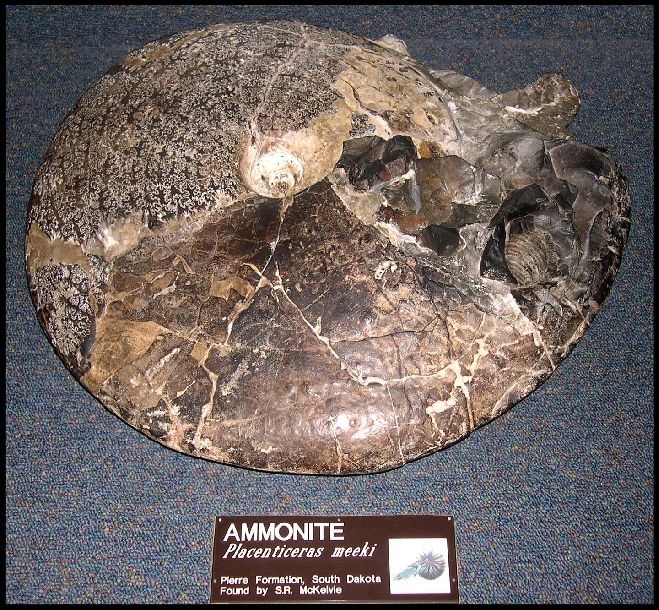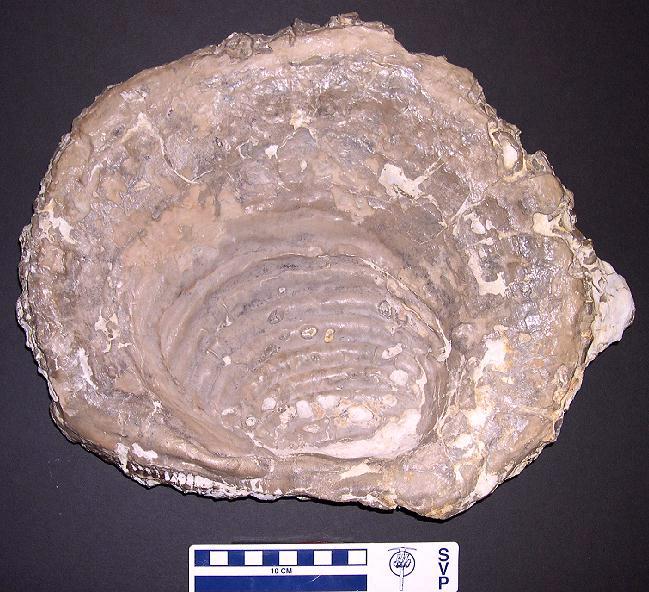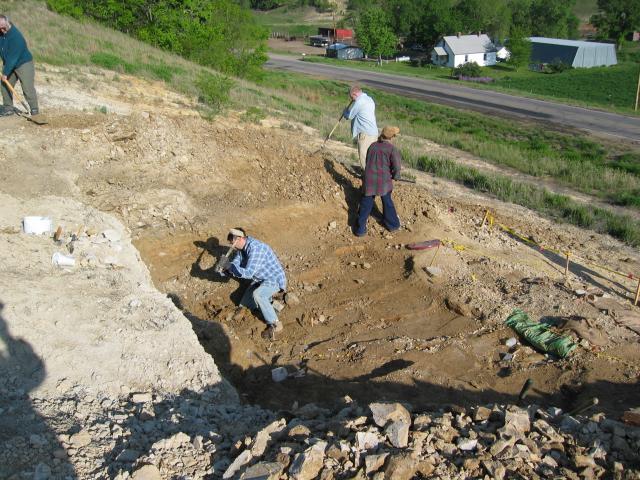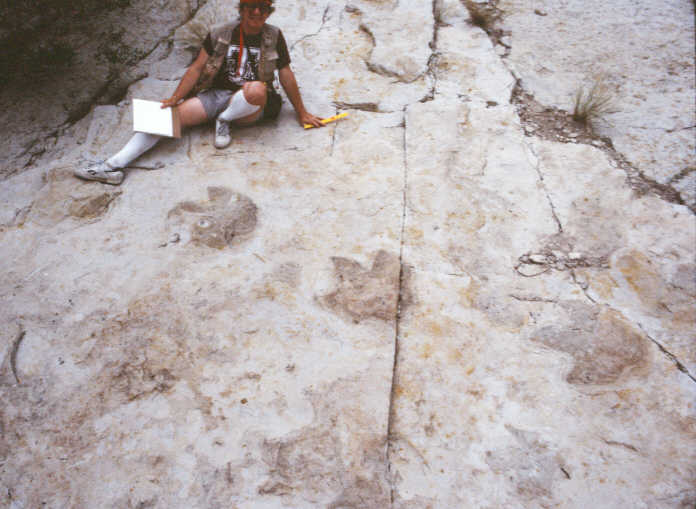Cretaceous Flora and Fauna of Nebraska
While many different types of organisms existed across the planet during the Cretaceous, the descriptions below highlight some of the most prominent creatures that would have been found in Nebraska. Relatively well-known animals such as fish are not discussed below, rather unfamiliar or extinct organisms from Nebraska will be the focus of this page.
Ammonites
Ammonites are an extinct group of cephalopods related to the modern-day Nautilus. They have been described by some as a "squid in a can." They propelled themselves backwards by shooting a jet of water from their siphon (under their head). Ammonites are very important for studies of Cretaceous geology because their evolutionary developmentwas fairly rapid, which makes them important for relative age dating of marine rocks. In Nebraska, Ammonites have been described mainly from the Pierre Shale, Niobrara Formation, and Greenhorn Limestone.
 |
An artistic representation of an ammonite from Mike Everhart's website: http://www.oceansofkansas.com/FieldGuide1.html |
 |
An ammonite specimenfrom the University of Nebraska-Lincoln State Museum (by Mike Everhart) http://www.oceansofkansas.com/FieldGuide1.html
|
Inoceramids
Inoceramids are an extinct group of bivalves (clams) that grew to enormous sizes (several feet across) during the Cretaceous. They were well-adapted to many different marine environments from shallow to deep waters. In Nebraska, they are very common in the Greenhorn Limestone and the Niobrara Formation.
 |
An Inoceramid (Volviceramus grandis) from the Coniacian (Late Cretaceous) of Kansas (by Mike Everhart). http://www.oceansofkansas.com/FieldGuide1.html |
Plesiosaurs
Plesiosaurs were large marine reptiles that were abundant in the Western Interior Seaway. They are not to be confused with dinosaurs, which only occurred on land. Several nearly complete Plesiosaur skeletons have been found from northeastern Nebraska around Niobrara State Park. These vertebrates are most commonly found in the deep water deposits of the Pierre Shale.
 |
Drawing of a Plesiosaur skeleton (from Mike Everhart). http://www.oceansofkansas.com/plesiosaur.html |
 |
Drawing of a Plesiosaur and photo of skeletal remains found in Kansas (from Mike Everhart). http://www.oceansofkansas.com/plesiosaur.html |
 |
Photo of a 2003 Plesiosaur excavation site in the Santee Sioux Nation, northeastern Nebraska. The individuals pictured are from the University of Nebraska State Museum. class="style4"> http://www.museum.unl.edu/research/vertpaleo/Ples/ index.html |
 |
Some of the neck vertebrae from the 2003 Plesiosaur excavationsite shown above. http://www.museum.unl.edu/research/vertpaleo/Ples/ index.htmlhtml |
Dinosaurs
While few if any dinosaur bones have been found in Nebraska, recent work published on the Dakota Formation in southeastern Nebraska suggests dinosaurs were present in the region during the Albian-Cenomanian. Ornithopod (bird-hipped) footprints have been discovered in sandstone units within the Dakota Formation. These prints suggest that dinosaurs were walking around on the coastal plains of Nebraska near the Western Interior Seaway during parts of the Cretaceous. To learn more about the first dinosaur tracks discovered in Nebraska, click HERE.
 |
Photograph from the University of Maryland showing Ornithopod tracks. http://www.geol.umd.edu/~tholtz/G104/lectures/ 104ornithop.html |
Calcareous Nannofossils
Calcareous nannofossils are the main constituent of chalks around the world from the Mesozoic to the recent. These plankton are extremely helpful in determining the relative age of marine sediments, as well as oceanographic conditions of ancient marine waters (i.e. temperatures, salinity, etc.). Although not as spectacularly exposed in Nebraska, the chalks of the Niobrara Formation are similar to the more famous chalk deposits across southern Great Britain (i.e. Chalk Cliffs of Dover). Besides the Niobrara Formation, chalk deposits also are known from the Greenhorn Limestone.
 |
Scanning Electron Microscope (SEM) view of a Cenomanian chalk from the Greenhorn Limestone of Kansas. Photo by Dr. David Watkins, University of Nebraska-Lincoln. http://www.geosciences.unl.edu/~dwatkins/ |
Flora
The only non-marine Cretaceous unit in Nebraska is the Dakota Formation. This terrestrial unit was composed mostly of coastal plain and estuary deposits. Terrestrial pollen has been used quite extensively for relative age dating and environmental interpretations of non-marine sediments adjacent to the Cretaceous Western Interior Seaway. Flowers first evolved during the Cretaceous and one of the oldest known flower fossils was found in the Dakota Formation in southeastern Nebraska. Besides flowers, gymnosperms (i.e. pine trees) and ferns would have been the dominant types of plants on the Nebraska landscape during the Cretaceous.
 |
Microscopic views of several types of pollen grains from the Dakota Formation in southeastern Nebraska (from Jesse Koch M.S. Thesis, 2007, University of Iowa). The top two photographs are gymnosperm (pine tree) pollen. The lower right photo is a fern spore, and the bottom left image is angiosperm (flower) pollen. |